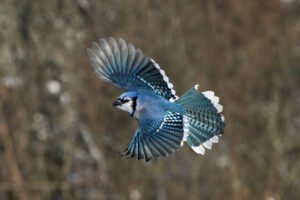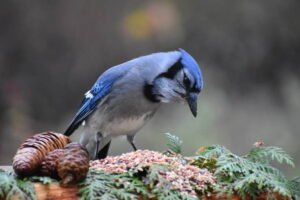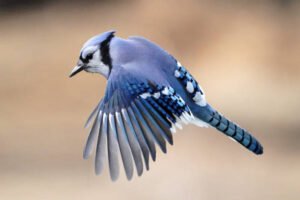
Introduction
Greetings from the fascinating world of vibrant birds! You have likely seen the stunning Blue Jay if you are a bird watcher or enjoy colorful creatures in nature. In the world of birds, this captivating creature is an excellent showstopper with its eye-catching blue plumage and unique sounds. We’ll delve into the intriguing world of blue jays in this blog post and provide you with all the knowledge you need to recognize them in the wild. We’ll go over everything, including their distinct behaviors and physical traits. So grab your binoculars and prepare for an exciting journey as we reveal these magnificent birds’ secrets! Together, let’s soar on this exploratory voyage.
Physical Description
The brilliant colors and distinctive traits of the Blue Jay make it an impressive bird to behold. Its body is medium, typically 9–12 inches long and 13–17 inches in wingspan. The Blue Jay’s striking blue upper body plumage, contrasted with white underparts, is its most distinctive feature. It has a crest on its head that may raise or lower to suit its mood. This crest enhances the bird’s overall royal aspect. It also has black patterns resembling masks around its eyes and collar area.
The robust, sharp bill of the Blue Jay is ideal for breaking open nuts and seeds. Despite their relative shortness, their legs are powerful enough to let them move quickly through trees. Despite having comparable physical traits, the female of this lovely species tends to be a little duller in color than the male. This is an intriguing fact about it. The Blue Jay is a species easily recognized in the wild thanks to its characteristic blue coat and striking facial features.
Habitat and Behavior
The incredibly versatile blue jay can be found in many environments, such as parks, forests, woodlands, and even suburban areas. For nesting and food sources such as acorns, nuts, seeds, fruits, insects, and occasionally other birds’ eggs or nestlings, they like regions with many trees. These vibrant animals are renowned for their social skills and intellect. During the breeding season, blue jays frequently form small family groups, but they can also get together in more enormous flocks during the winter. They use a variety of calls to communicate with one another, from loud squawks to gentle whistles.
The tendency of food caching exhibited by Blue Jays is an intriguing behavior. When there is an excess of food, these astute birds will gather extra and stash it away for later use. By forgetting where they concealed their caches, they unintentionally plant new trees, which aids in forest regeneration in addition to helping them live during times of food scarcity! Even though they are not typically migratory, some Blue Jays may travel south in the event of a severe winter or a reduction in food sources in their native area.

Thus, the next time you see a flash of vivid blue scuttling through the treetops or hear its unique call resonating through the forest, stop and consider the adaptability and social dynamics of these amazing creatures!
Identifying Features and Distinctive Calls
In addition to their distinctive blue plumage, blue jays can also be recognized in the wild by other distinguishing characteristics. The top of these birds’ heads have a crest that they may raise or lower to suit their mood. Their remarkable look is enhanced by the black bands that cover their wings and tail feathers. A highly distinguishing feature of the Blue Jays is their call. Most likely, a Blue Jay is making the loud, boisterous “jay-jay” sound that is resonating through the woods. They may also make a variety of vocalizations, including mimicking human sounds and other bird cries.
It’s crucial to listen for these distinctive vocalizations while attempting to identify a Blue Jay based only on its call. Take note of any changes in tone and volume, as well as the call’s pitch and rhythm. You’ll quickly get better at identifying these different calls with practice! Apart from their physical characteristics and vocalizations, Blue Jays exhibit specific actions that can facilitate their identification. These birds are pretty gregarious and are frequently observed flying in pairs or small groups. When they are jumping around trees or quickly scanning the ground for food, they are also quite active.
To successfully identify a Blue Jay by its behavior:
- Watch how it interacts with nearby birds.
- Keep an eye out for aggressive posturing or chasing away intruders from their feeding area as examples of territorial displays.
- Recall that although several birds may appear similar to Blue Jays from a distance owing to comparable colors or patterns, it is crucial to concentrate on particular distinguishing characteristics, such as the crest and black banding on wings, before identifying.
It takes acute observational abilities, in addition to an understanding of the physical characteristics, calls, and behaviors of the Blue Jay, to spot and identify one.
Other Birds that Resemble Blue Jays
There can be some uncertainty at times when it comes to bird identification. The Steller’s Jay is one bird frequently confused for a blue jay. These two birds are similar in that they have black markings on their heads and blue plumage. Nevertheless, you can distinguish between them thanks to a few significant variations. The vivid royal blue of the Blue Jay is contrasted with a darker shade of blue in the Steller’s Jay. In addition, the Steller’s Jay has a distinguishing crest that stands straight, giving it a significantly different appearance from the other birds despite having black patterns on their heads.

The Western scrub jay is another type of bird resembling the Blue Jay. Its vivid blue feathers are similar to those of the Blue Jay, but it does not have the black markings on its head or the white underparts. Instead, the abdomen and chest of the Western Scrub-Jay are covered in light grayish-blue feathers. It’s crucial to remember that these similarities are surface-level; to correctly identify these birds in the wild, you must pay great attention to minute characteristics.
Common Misconceptions about Blue Jays
There are several widespread myths about blue jays, making them misunderstood birds. To clear up some of these misunderstandings, let’s examine them in more detail. The idea that blue jays are hostile to other birds is one common misperception. Although they can be territorial during the breeding season, blue jays usually live in harmony with other bird species. They rarely go into violent fights, even if they might demonstrate their superiority over food sources.
There’s also a myth that blue jays solely consume seeds. Although they consume certain grains, bluejays are omnivores with various tastes. Insects, fruits, nuts, and even tiny vertebrates like mice or frogs are among the foods they relish eating. Some think that blue jays are invariably represented by whatever blue-colored bird they see. This isn’t always the case, though, as certain bird species—like eastern bluebirds and indigo buntings—have comparable coloring. Accurate bird identification requires attention to particular traits and behaviors.
It is a common misconception that giving Blue Jays breadcrumbs will help them. In actuality, bread has little nutritional value for these birds and, if consumed frequently, might cause health issues. When luring them into your backyard, use natural food sources like mealworms or sunflower seeds instead of processed meals or bread crumbs. Through factual information and in-the-wild observation, we may debunk prevalent preconceptions about blue jays and get a deeper appreciation for these magnificent birds of prey. After all, they are intelligent, adaptive individuals that thrive in our natural environments. So, let’s take advantage of this chance to study more about blue jays.
Tips for Spotting Blue Jays in the Wild
Look for the vivid blue color: The striking blue plumage of Blue Jays is one of its distinguishing characteristics. As you look among the bushes and trees, watch for bursts of vivid blue.
Pay attention to their unique call: The Blue Jay has a clear, powerful call that frequently resembles a harsh “jay-jay” or a string of rattling notes. You can quickly detect their presence in the region if you become familiar with their distinct sound.
Observe their behavior: Blue Jays are known to be lively and curious birds. They are frequently observed playfully interacting with other birds or hopping from branch to branch for food.
Look by oak trees or bird feeders: Due to their preference for acorns, nuts, and seeds, these perceptive birds will likely travel to areas with abundant food supplies. Generally, the best places to find them are around oak trees or bird feeders.
Try using binoculars: Blue Jays can occasionally be challenging to identify without them, mainly if they are high in treetops or far distant in wide-open spaces.
Be mindful and patient: Remember that the natural world follows its schedule, so look for Blue Jays! You may see these lovely creatures going about daily if you take your time, remain motionless, and pay attention to your surroundings.
When exploring outdoor regions rich in flora and wildlife, keep these ideas in mind and pay close attention to your surroundings to increase your chances of seeing these impressive birds in the wild!
How to Attract Blue Jays to Your Backyard
A fun experience for anyone who enjoys watching wildlife or is a bird lover is luring blue jays into your property. These fantastic birds will bring color to your outside area with vivid blue feathers and characteristic crests. The following advice can help you attract blue jays to your yard:

Give the Correct Food: Nuts, seeds, insects, and fruits are among the many foods blue jays eat. Serve a mixture of suet cakes, peanuts in their shells, and sunflower seeds to draw them in. As treats, you might also scatter some chopped apples or grapes.
Install Bird Feeders: It’s crucial to have well-stocked feeders for larger birds, such as bluejays. Choose hopper-style feeders or platforms with wide perches to fit their size.
Provide Water and Shelter: Blue Jays adore trees! In addition to giving them cover, planting native trees in your yard will draw insects they can eat. In addition, think about including shallow water dishes or birdbaths so they can bathe and drink.
Steer clear of chemicals: Applying insecticides or herbicides to your yard could endanger the animals you’re attempting to draw in, like blue jays! Instead, choose organic pest control techniques.
Keep in mind that drawing in wildlife requires persistence and effort; it can take some time before blue jays begin to visit your backyard often. So please take a seat, unwind, and enjoy the beauty of these birds as they decorate your outdoor sanctuary!
Dos and Don’ts When Interacting with Blue Jays
There are a few critical considerations while engaging in wild interactions with blue jays. These remarkable birds can be susceptible animals despite their beauty and fascination. Here are some crucial pointers to make sure that the exchange is constructive. Do keep a respectful distance from these magnificent creatures, even if it would be tempting to get up close and personal with them. If you want a closer view, use a zoom lens or binoculars.
Please don’t give them junk food: Blue Jays have specific nutritional requirements, so avoid giving them processed or fatty items like breadcrumbs or chips. Opt for natural options like suet, sunflower seeds, or unsalted peanuts. Do supply clean water: Blue jays require access to clean water for bathing and drinking. Your backyard can become a welcoming haven for these feathered companions with the addition of a birdbath or shallow dish filled with fresh water.
Refrain from approaching their nests: When out and about in the outdoors, if you happen upon a blue jay nest, try not to get too close or agitate it in any way. During the nesting season, it’s essential to respect their dwellings and give them space. Make your surroundings bird-friendly by planting native trees and shrubs, which will draw blue jays by giving them access to acorns and berries, their favorite foods. Always put the welfare of blue jays before your curiosity or enjoyment worthwhile engaging with them in the outdoors! You may enjoy watching these amazing birds without hurting them if you abide by these straightforward dos and don’ts.
FAQs
Q: Can you locate Blue Jays throughout North America?
A: Indeed, blue jays are widespread all over North America, from the Gulf Coast to southern Canada.
Q: Are birds known as blue jays migratory?
A lot of Blue Jay populations are non-migratory and remain in their areas all year long, yet others do move.
Q: What is the lifespan of the Blue Jays?
A: Blue Jays live for roughly seven years on average. On the other hand, some have lived to be 17 years old!
Q: How can I best get the Blue Jays to come to my backyard?
A: Various meals, including peanuts, sunflower seeds, and suet feeders, will draw in blue jays. Additionally, you can provide shallow dishes or bird baths as water sources.
Q: Is a spotting scope or binoculars necessary for a precise identification of a Blue Jay?
A: Blue Jays are pretty large and easily identifiable birds with their brilliant colors and unique crests, so using binoculars or spotting scopes is not necessary. On the other hand, having these instruments at your disposal will improve your birding experience by enabling you to get closer to the birds.





